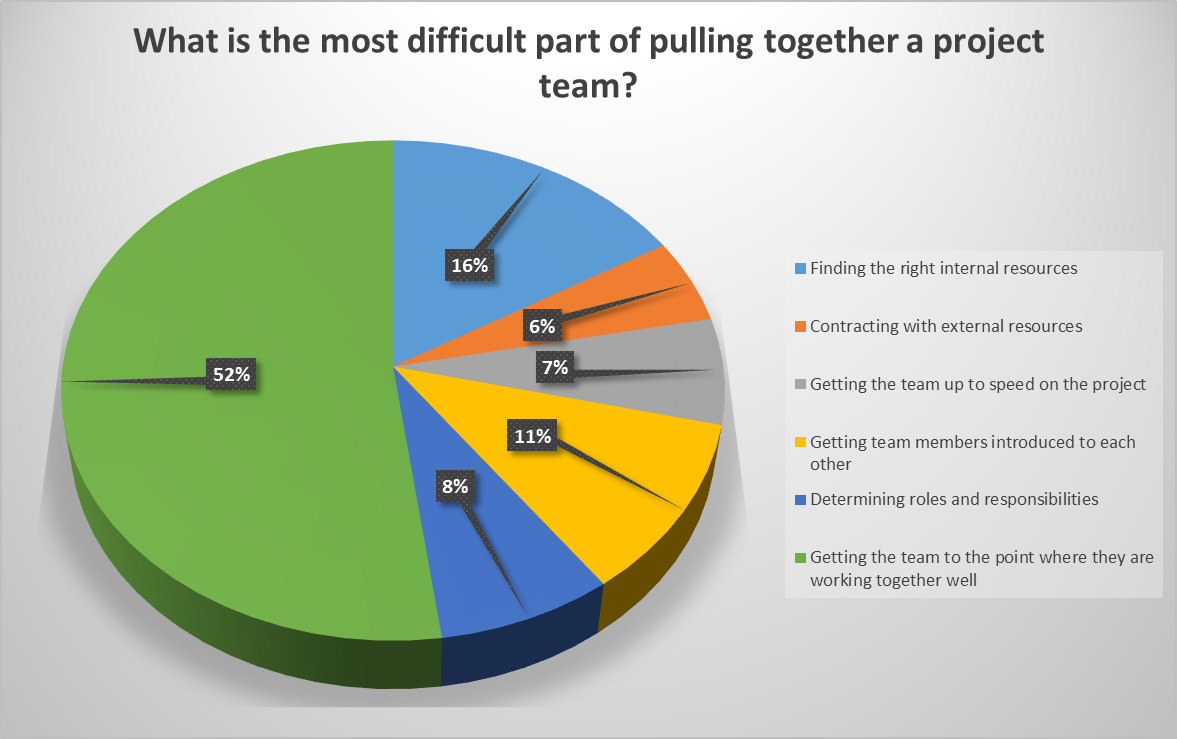Responses to a Poll Question and a Client Story
A poll question1 asked of 700 project managers, project team leads, and program directors regarding their opinion of the most difficult part of pulling together a project team, delivered the following responses:
|
Option |
Number of Responses |
|
Finding the right internal resources (mix of skills, availability) |
115 |
|
Contacting with external resources in a timely manner |
38 |
|
Getting the team up to speed on the project |
48 |
|
Getting team members introduced to each other; enabling for relationship building |
79 |
|
Determining roles and responsibilities on the project team |
55 |
|
Getting the team to the point where they are working together effectively and efficiently |
365 |

What the results tell us
Bearing in mind that the poll is not statistically accurate, let’s explore further the gap in the number of responses. The most popular response – Getting the team to the point where they are working together effectively and efficiently – goes directly to the need for team building. For every project I have kicked off for a client, I differentiate between kicking off the project and kicking off the project team. Let me share how this is done through sharing a client story.
A client story
Let me share the story of one of ACG’s clients, a financial services firm. During a presentation I did on best practices for engaging and managing project teams at a conference, a manager of the CTO who attended mentioned that he wanted to arrange a meeting between me and his manager, the CTO to discuss some of their particular challenges with technology teams.
The Chief Technology Officer (CTO) and I met so that he could share the particular challenge noted by his manager. In particular, each time the technology group launched a project that involved cross-functional teams, it took quite a bit of time to get the team up and running. When we asked specifics about what he meant, he shared that on average, it took a cross-functional technology project team about 1 ½ to 2 months to begin to work together fairly well. This caused many complex technology initiatives to lose precious time in making deadlines and therefore most projects were delivered later than desired. There were a number of other issues he mentioned; they all led back to no time spent to enable the team to get to know each other and collaborate to plan the projects. The organization launched projects and immediately moved to starting work on the tasks. Part of this was due to a perception by leadership that if you were no working on the project’s tasks, you were not working.
How ACG would help
We agreed that ACG would co-lead the next project to be launched by the CTO. Our main responsibility would be to manage the team building and team engagement component of the project, and the client’s project manager would manage building the plan and getting the project work completed.
This was a perfect time to develop new processes and best practices for getting a project started as this was a complex initiative that involved over 25 project team members from throughout the organization. They represented every department and workgroup. The project was 16 months in duration and had 15 deliverables associated with it.
We pulled the team together in one location as that would enable for an easier time in building relationships among the team members. The more comfortable they became with each other, the easier they would be able to collaborate toward achieving the goals of the initiative.
The initial team meeting
The initial team meeting was two days in duration. At a high level, the two days covered:
- A team building activity that was started prior to the session (which encouraged team members to reach out to each other prior to meeting)
- Team dinners
- Another team building activity that was focused on smaller groups of team members (and in particular those who would be working together most closely during the project duration)
- Information about the project – its purpose, scope, timeline, alignment to the organizational strategy and the impact the project would have throughout the organization, as well as roles and responsibilities on the project
- Breakout groups worked on are variety of project-related best practices including:
- identifying risks, building out the initial project plan, developing processes for resolving conflicts, sharing work, collaborating, solving problems and making decisions
The team left after two days ready to move forward with beginning the work of the project. These two days – spent in planning the project and getting to know each other – enabled for a quicker start to the team collaborating to accomplish the project goals.
A link back to the poll question
Refer back to our poll, and in particular the 365 (52%) responses to the challenge: Getting the team to the point where they are working together effectively and efficiently.
When time is allotted to the team to get together prior to beginning work on the tasks of the project – whether in person (preferred of course!) or virtually – they are more likely to collaborate more effectively. This time together enables for the team members to get to know each other, learn how best to work together to accomplish the goals of the project and determine specific processes, procedures and best practices for collaborating.
Check out one of our past articles on the five stages of team development and the role of the project manager.
1 The poll question was launched on a variety of sites and should not be considered statistically accurate. The options were provided to those responding to the survey; there was no “other” option available. It is possible that respondents replied more than once since the poll was offered on a number of sites.


